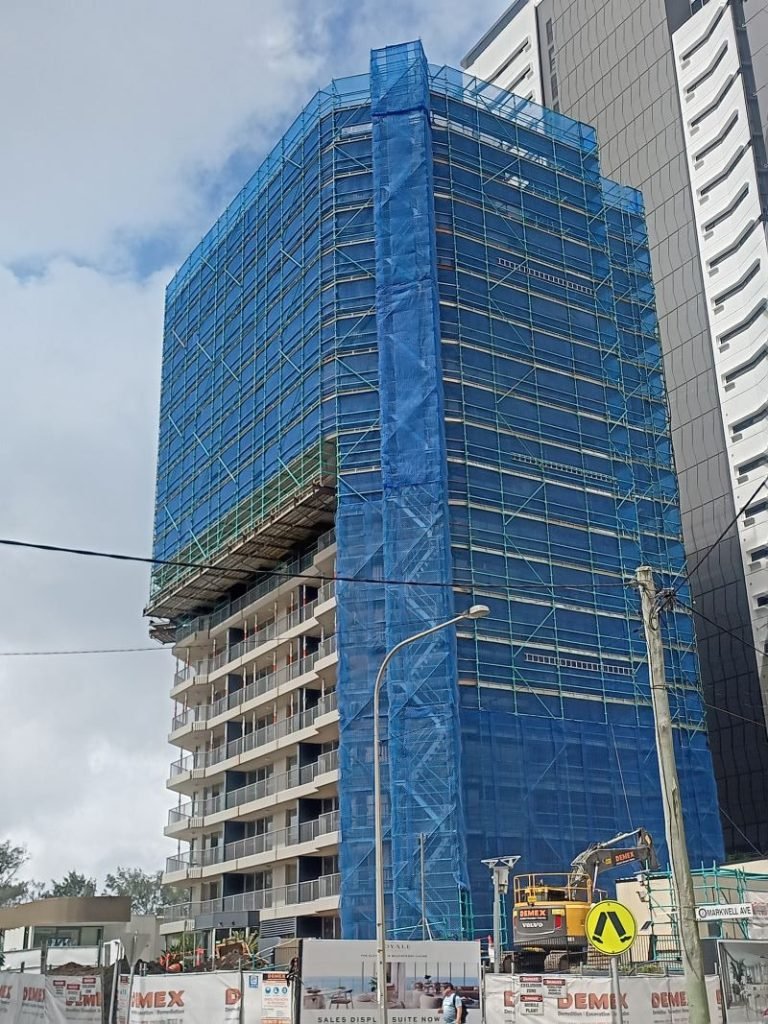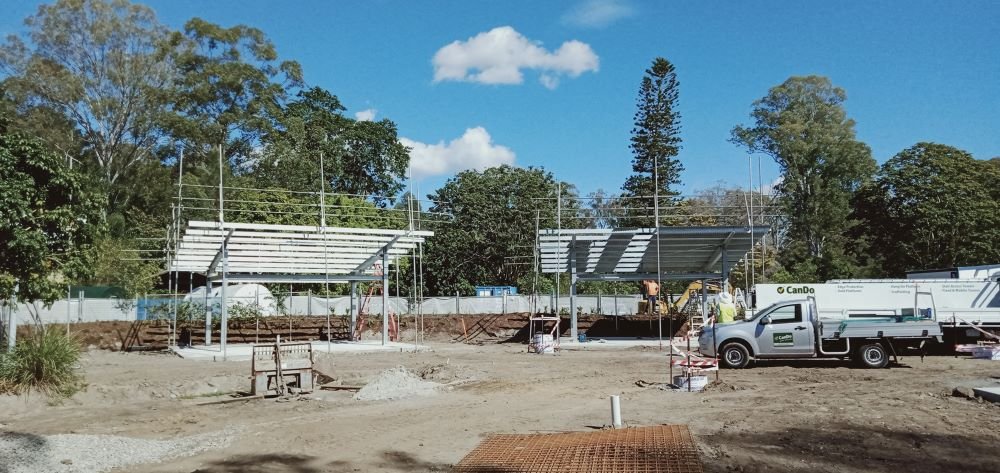Key Stages and Safety Considerations
Scaffolding is a crucial element in building construction, providing workers with safe access to elevated areas and supporting materials during the building process. You might wonder when exactly scaffolding is erected on a construction site. Scaffolding is typically erected at the beginning of a construction project, just after the foundation has been laid and before major structural work begins.
The timing of scaffolding installation depends on various factors, including the size and complexity of the building, the construction methods used, and local safety regulations. For multi-storey buildings, scaffolding is often installed in stages as the structure grows taller, ensuring workers have continuous safe access to all levels.
Proper planning for scaffolding erection is essential to ensure worker safety and project efficiency. Before installation, construction managers assess the site, determine the type of scaffolding required, and create a detailed plan for its placement and use throughout the construction process. This careful preparation helps minimise risks and keeps the project running smoothly from start to finish.

Scaffolding Fundamentals
Scaffolding plays a crucial role in building construction, providing safe and stable platforms for workers to access elevated areas. It serves multiple purposes and comes in various types to suit different project requirements.
Definition and Purpose
Scaffolding is a temporary structure erected to support access or working platforms. Its primary purpose is to enable construction work at heights where ground-level access is not feasible.
You’ll find scaffolding used extensively in construction sites to facilitate tasks such as bricklaying, painting, and maintenance work. It ensures worker safety by providing stable platforms and guardrails.
Scaffolding also serves as a support structure for materials and equipment, improving efficiency on the worksite. It allows for the even distribution of weight and provides a secure foundation for workers to perform their duties.
Types of Scaffolding
There are several types of scaffolding used in construction, each designed for specific applications and site conditions.
Prefabricated steel modular scaffolding is one of the most common types. It consists of pre-made components that can be quickly assembled and disassembled, making it versatile and cost-effective.
Tube and coupler scaffolding uses steel tubes connected by couplers, offering flexibility in design for complex structures. This type is particularly useful for projects with irregular shapes or limited space.
Mobile scaffolding, mounted on castors, allows for easy movement around the worksite. It’s ideal for jobs that require frequent repositioning of the scaffold.
Suspended scaffolding, hung from the roof or a higher floor, is often used for work on tall buildings or structures where ground-based scaffolds are impractical.
Preparation for Scaffolding
Proper preparation is crucial for safe and efficient scaffolding erection. You’ll need to assess the site, consider safety measures, and acquire the necessary materials before beginning construction.
Site Assessment
Before erecting scaffolding, you must thoroughly evaluate the construction site. Check the ground conditions to ensure they can support the scaffold’s weight. Look for any potential hazards like overhead power lines or uneven terrain.
Measure the area where the scaffold will be placed and determine the height required. This will help you calculate the amount of materials needed.
Consider the building’s structure and any architectural features that might impact scaffold placement. You’ll need to plan for windows, balconies, and other projections.
Assess weather conditions and how they might affect the scaffolding. Strong winds or heavy rain can pose significant risks during erection and use.
Safety Considerations
Safety is paramount when preparing for scaffolding erection. You must ensure compliance with regulations and industry standards.
Develop a comprehensive safety plan that outlines procedures for erection, use, and dismantling. This plan should include emergency protocols and fall protection measures.
Ensure all workers involved in scaffold erection are properly trained and certified. They should be familiar with the specific type of scaffolding being used.
Identify and acquire necessary personal protective equipment (PPE). This typically includes hard hats, safety glasses, gloves, and fall arrest systems.
Plan for regular inspections and maintenance of the scaffolding once erected. This will help maintain safety throughout the construction process.
Material Acquisition
Procure high-quality scaffolding materials from reputable suppliers. This includes frames, boards, braces, couplers, and base plates.
Calculate the quantity of each component needed based on your site assessment and scaffold design. It’s wise to order extra materials to account for unforeseen circumstances.
Ensure all materials meet current safety standards and are in good condition. Inspect each piece for damage or wear before use.
Gather the necessary tools for scaffold erection, such as spirit levels, scaffolding spanners, hammers, and measuring tapes.
Arrange for secure storage of materials on-site to protect them from theft or weather damage. Proper storage also helps maintain an organised work area.
Erection Process
Proper scaffolding erection involves a systematic approach, clear team roles, and rigorous quality checks. These elements ensure a safe and efficient structure to support construction work.
Assembly Sequence
Begin by laying out base plates on a firm, level surface. Place adjustable jacks on the plates to provide a stable foundation. Next, erect vertical standards and connect them with ledgers and transoms to form the basic frame.
Add additional levels by repeating this process, ensuring each level is secure before moving up. Install guardrails, toe boards, and work platforms as you go. Use diagonal braces to increase stability.
Prefabricated steel modular scaffolding is common in commercial and residential buildings. Follow manufacturer instructions for specific assembly requirements.
Team Responsibilities
Designate a competent supervisor to oversee the erection process. This person must have a certificate of competency and ensure all safety protocols are followed.
Assign specific roles to team members:
- Ground crew: Manage material supply and base stability
- Assembly crew: Erect scaffold components
- Safety officer: Monitor work practices and equipment use
Ensure clear communication between team members. Use hand signals or radios when necessary. Hold regular safety briefings to address any concerns or changes in the erection plan.
Quality Assurance
Implement a thorough inspection process throughout the erection. Use a checklist to verify each component’s proper installation and condition.
Key inspection points include:
- Level and plumb of standards
- Secure connections between components
- Proper installation of guardrails and toe boards
- Stability of work platforms
Conduct load testing as required by local regulations. Document all inspections and tests for future reference. Address any issues immediately before proceeding with further assembly.
Regular maintenance checks during use are crucial. Schedule periodic inspections to ensure ongoing scaffold integrity and safety.

Scaffolding Regulations
Scaffolding regulations in Australia aim to ensure worker safety and structural integrity on construction sites. These rules cover design standards, inspection requirements, and compliance measures that all builders and contractors must follow.
Australian Standards
The AS/NZS 1576 series sets out the key standards for scaffolding in Australia. You must ensure your scaffolding meets these specifications:
- AS/NZS 1576.1 covers general requirements
- AS/NZS 1576.2 deals with couplers and accessories
- AS/NZS 1576.3 focuses on prefabricated and tube-and-coupler scaffolding
Your scaffolding must be capable of supporting its own weight plus at least 4 times the maximum intended load. You need to use only approved materials and follow proper assembly techniques.
Inspection and Compliance
You must regularly inspect your scaffolding to maintain compliance. WorkSafe authorities require:
- Initial inspection before use
- Re-inspection after any incident that may affect stability
- Routine checks at least every 30 days
Keep detailed records of all inspections. Only licensed scaffolders can erect, alter, or dismantle scaffolding over 4 metres high. You must display the scaffold’s safe working load clearly.
Failure to comply with regulations can result in hefty fines and work stoppages. Prioritise safety by staying up-to-date with all relevant scaffolding laws and standards.
Local Scaffolders
For Scaffolding installation or advice for South East Queensland –
Get in touch with CanDo Scaffolding
Frequently Asked Questions
Scaffolding regulations and practices can be complex. These common questions address key safety standards, height requirements, installation processes, and qualified personnel for scaffolding on construction sites.
What are the regulatory requirements for edge protection before scaffolding installation?
Edge protection must be in place before scaffolding installation begins. This includes guardrails, toe boards, and safety nets where necessary. The height of guardrails should be between 900mm and 1100mm above the working platform.
Toe boards must be at least 150mm high and securely fixed to prevent tools or materials from falling. Safety nets may be required for additional protection in high-risk areas.
Who is qualified to erect mobile scaffolds that are rented?
Competent persons are qualified to erect mobile scaffolds, including those that are rented. These individuals must have proper training, experience, and knowledge of scaffolding systems.
In Australia, this typically means holding a scaffolding high-risk work licence. For basic mobile scaffolds under 4 metres, a person with appropriate training and experience may be sufficient.
What are the scaffolding safety standards and regulations in Victoria?
Victoria follows the national Work Health and Safety Regulations for scaffolding. Key requirements include:
- Regular inspections by competent persons
- Proper documentation of scaffold designs and risk assessments
- Adherence to load limits and height restrictions
- Use of appropriate fall protection systems
WorkSafe Victoria provides specific guidelines for tower frame scaffolds, including requirements for erection, dismantling, and use.
At which specific heights is scaffolding compulsory on construction sites?
Scaffolding becomes compulsory when work cannot be safely performed from the ground or a stable platform. Generally, scaffolding is required for work at heights of 2 metres or more.
However, risk assessments may determine that scaffolding is necessary at lower heights depending on the task, duration, and work environment.
What are the necessary steps involved in the construction scaffolding process?
The construction scaffolding process involves several key steps:
- Site assessment and planning
- Selection of appropriate scaffolding type
- Erection by qualified personnel
- Inspection and certification before use
- Regular maintenance and inspections during use
- Safe dismantling and removal
Each step must comply with safety regulations and be carried out by competent individuals.
Could you explain the ‘3 to 1’ rule applied within scaffolding practices?
The ‘3 to 1’ rule in scaffolding refers to the height-to-base ratio for freestanding scaffolds. The rule states that the height of the scaffold should not exceed three times the minimum base dimension.
This rule helps ensure stability and prevents tipping. For example, a scaffold with a minimum base width of 2 metres should not exceed 6 metres in height without additional stabilisation measures.
